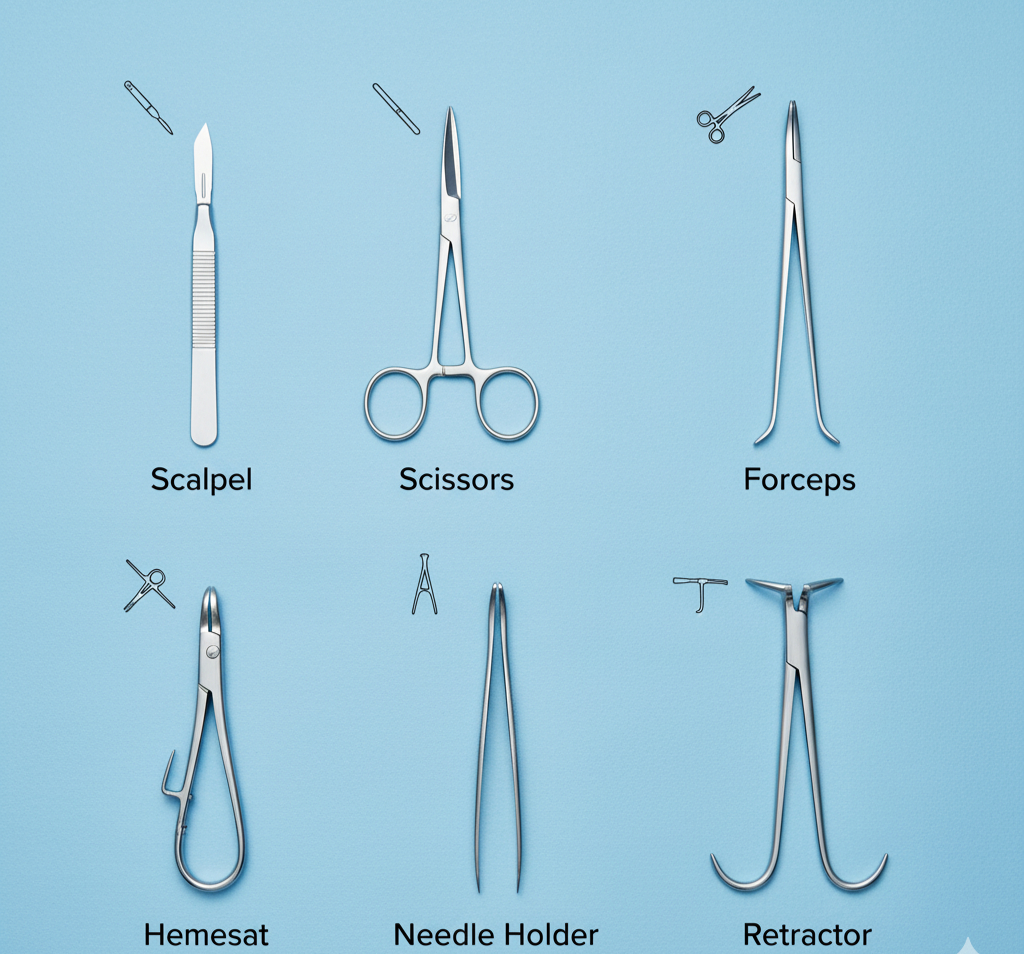In healthcare, precision and safety are only possible when the right tools are used. Surgeons, doctors, and nurses depend on surgical instruments for every procedure. For students, professionals, and buyers, knowing surgical instruments name with picture is essential. This guide explains the types of surgical instruments, their names, uses, and the importance of images for learning and procurement.
Why Surgical Instruments Name with Picture Matters
Medical science relies on accuracy, and correct instrument identification is a vital part of it.
- For Medical Students – Pictures with names help in learning faster.
- For Surgeons and Nurses – Ensures quick recognition during operations.
- For Buyers & Distributors – Avoids confusion when placing bulk orders.
- For Hospitals & Clinics – Streamlines inventory management.
Categories of Surgical Instruments Name with Picture
Surgical instruments are classified into different categories depending on their function.
Cutting and Dissecting Instruments
These are designed to cut skin, tissues, and other materials during surgery.
- Scalpel – A small, sharp blade for precise incisions.
(Picture: Sterile stainless steel scalpel on blue drape) - Surgical Scissors – Available in straight or curved designs for tissues or sutures.
(Picture: Pair of curved surgical scissors) - Bone Cutter – Used in orthopedic surgery for cutting bones.
(Picture: Heavy-duty bone cutting plier)
Grasping and Holding Instruments
Used to hold tissues, needles, or medical materials.
- Forceps – Available in toothed and smooth versions.
(Picture: Stainless forceps with serrated tips) - Needle Holder – Securely grips the needle during suturing.
(Picture: Mayo-Hegar needle holder) - Towel Clamp – Holds drapes or tissues in place.
(Picture: Sterile towel clamp with locking handle)
Clamping and Occluding Instruments
These instruments help control bleeding and blood flow.
- Hemostats – Clamp blood vessels during surgery.
(Picture: Curved hemostat with serrated jaws) - Artery Forceps – Used to secure arteries.
(Picture: Long artery forceps for vascular procedures) - Bulldog Clamp – Small clamp for delicate vascular surgeries.
(Picture: Bulldog clamp with spring handle)
Retracting and Exposing Instruments
Provide better visibility of the surgical site.
- Retractors – Used to hold tissues apart.
(Picture: Self-retaining surgical retractor) - Speculum – Common in gynecology and ENT procedures.
(Picture: Stainless vaginal speculum) - Skin Hook – Retracts skin gently during delicate surgeries.
(Picture: Double-prong skin hook)
Suturing and Stapling Instruments
Used for closing wounds after procedures.
- Needle Holder – Guides the needle when stitching.
(Picture: Needle holder with ratchet lock) - Surgical Stapler – Closes incisions quickly with staples.
(Picture: Disposable surgical stapler) - Suture Scissors – Specifically designed for cutting sutures.
(Picture: Lister suture scissors with angled blade)
Specialized Surgical Instruments
Different specialties use unique instruments.
Dental Surgical Instruments Name with Picture
- Extraction Forceps (Picture: Dental extraction forceps)
- Elevators (Picture: Dental root elevator)
- Scalers (Picture: Periodontal scaler)
ENT Surgical Instruments Name with Picture
- Ear Speculum (Picture: ENT ear speculum set)
- Nasal Speculum (Picture: Stainless nasal speculum)
- Laryngoscope (Picture: Fiber optic laryngoscope with handle)
Orthopedic Surgical Instruments Name with Picture
- Bone Drill (Picture: Manual orthopedic bone drill)
- Plates and Screws (Picture: Orthopedic implant set)
- Orthopedic Saw (Picture: Surgical oscillating saw)
Benefits of Surgical Instruments with Name and Picture
Using instruments with clear images and names provides:
- Accuracy in learning for medical students.
- Confidence in surgery with correct tool selection.
- Ease of purchasing for distributors and hospitals.
- Standardization in international trade and education.
How to Maintain Surgical Instruments
To keep instruments effective and sterile:
- Clean immediately after use.
- Sterilize via autoclaving or chemical methods.
- Store in dry, sterile packaging.
- Inspect regularly for wear or damage.
Where to Find Surgical Instruments Name with Picture
1. Manufacturer Catalogs
Professional exporters provide product catalogs with images and names.
2. Online Marketplaces
Websites like Alibaba, Amazon, and medical e-commerce stores.
3. Training Resources
Medical textbooks and online learning platforms.
Why Choose Professional Enterprises
At Professional Enterprises, we manufacture and export premium surgical instruments with names and pictures.
Our Advantages
- High-quality German stainless steel.
- International certifications (ISO, CE, FDA).
- Complete catalog with product codes and images.
- Private labeling and branding.
- Worldwide delivery with competitive pricing.
FAQs About Surgical Instruments Name with Picture
Q1: Why are pictures important with surgical instrument names?
They help in clear identification and avoid mistakes during surgeries or purchases.
Q2: Can I get a complete catalog of surgical instruments?
Yes, manufacturers like Professional Enterprises provide catalogs with names, pictures, and product codes.
Q3: Which surgical instruments are most common?
Scalpels, scissors, forceps, clamps, and retractors are among the most used.
Q4: Do instrument names vary worldwide?
Most follow international standards, but regional variations exist.
Conclusion
Understanding surgical instruments name with picture is crucial for students, professionals, buyers, and healthcare institutions. Images with names improve learning, ensure accuracy in operations, and simplify procurement.

